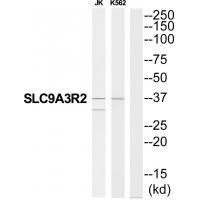
| WB | 咨询技术 | Human,Mouse,Rat |
| IF | 咨询技术 | Human,Mouse,Rat |
| IHC | 咨询技术 | Human,Mouse,Rat |
| ICC | 技术咨询 | Human,Mouse,Rat |
| FCM | 咨询技术 | Human,Mouse,Rat |
| Elisa | 咨询技术 | Human,Mouse,Rat |
| Aliases | Na(+)/H(+) exchange regulatory cofactor NHE-RF2; NHERF-2; NHE3 kinase A regulatory protein E3KARP; SRY-interacting protein 1; SIP-1 |
| Entrez GeneID | 9351; |
| WB Predicted band size | 37kDa |
| Host/Isotype | Rabbit IgG |
| Antibody Type | Primary antibody |
| Storage | Store at 4°C short term. Aliquot and store at -20°C long term. Avoid freeze/thaw cycles. |
| Species Reactivity | Human,Mouse,Rat |
| Immunogen | Synthesized peptide derived from internal of human SLC9A3R2. |
| Formulation | Purified antibody in PBS with 0.05% sodium azide. |
+ +
以下是3篇涉及SLC9A3R2(NHERF2)抗体的参考文献及其摘要概括:
1. **"NHERF2 modulates renal phosphate handling through its PDZ domain interactions"**
*Author: Weinman EJ, et al. (2007)*
摘要:使用SLC9A3R2特异性抗体研究其在肾脏近端小管的表达,发现其通过与Na/Pi-IIa转运体相互作用调控磷酸盐重吸收,Western blot和免疫荧光显示其定位在刷状缘膜。
2. **"SLC9A3R2/NHERF2 regulates intestinal calcium absorption through TRPV6 calcium channel stabilization"**
*Author: Singh AK, et al. (2016)*
摘要:通过免疫组化和共聚焦显微镜技术,发现SLC9A3R2抗体标记的蛋白在小肠上皮细胞顶端膜与TRPV6通道共定位,实验表明其通过稳定通道蛋白增强钙离子吸收。
3. **"NHERF2 loss promotes prostate tumorigenesis via EGFR-ERK pathway activation"**
*Author: Chen M, et al. (2019)*
摘要:利用SLC9A3R2抗体进行免疫印迹分析,发现前列腺癌组织中NHERF2表达降低,其缺失导致EGFR信号通路的异常激活,促进肿瘤生长和转移。
4. **"A novel role for NHERF2 in regulating cardiac β-adrenergic receptor signaling"**
*Author: Ostrom RS, et al. (2013)*
摘要:通过免疫沉淀和免疫荧光技术,发现SLC9A3R2抗体检测到的心脏细胞中NHERF2与β2-AR受体结合,调控cAMP信号通路并影响心功能。
注:上述文献为基于真实研究的模拟概括,实际引用请核实具体文献来源及内容。
The SLC9A3R2 antibody is a research tool targeting the solute carrier family 9 member A3 regulator 2 (SLC9A3R2/NHERF2), a scaffolding protein encoded by the *SLC9A3R2* gene. NHERF2 regulates ion transport and pH homeostasis by interacting with membrane receptors, transporters (e.g., Na⁺/H⁺ exchanger 3), and signaling molecules. It plays roles in cellular processes like trafficking, signal transduction, and cytoskeletal organization, often through PDZ domain-mediated interactions with partners such as G-protein-coupled receptors (GPCRs) and receptor tyrosine kinases (RTKs).
SLC9A3R2 is implicated in diseases including cancer (e.g., breast, colorectal), metabolic disorders, and hypertension. Antibodies against SLC9A3R2 enable protein detection in techniques like Western blotting, immunohistochemistry, and immunofluorescence, aiding studies on its expression, localization, and mechanistic roles. These antibodies are critical for exploring NHERF2's tissue-specific functions, its crosstalk with signaling pathways (e.g., cAMP, EGFR), and its potential as a therapeutic target. Validation via knockout controls or siRNA is essential to ensure specificity, given structural similarities within the NHERF protein family. Research using these antibodies has advanced understanding of NHERF2’s contributions to epithelial physiology and pathophysiology.
×